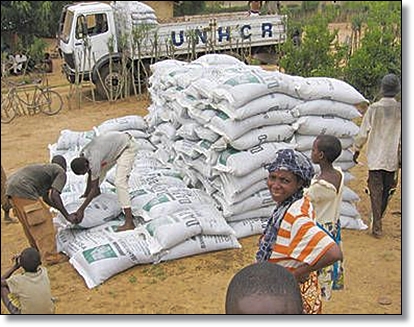Fertilizer Subsidy Programs in Africa Scrutinized

 |
| Fertiliser subsidy in Malawi Photo courtesy |
The workshop, organized by the Food Agricultural Organization (FAO) had farmers’ unions, private input dealers, agricultural ministries and development bodies share knowledge, explore successes and propose solutions to challenges bedeviling FSP successful implementation in Africa. The workshop also examined if the program has been key to fighting food insecurity in Africa where it’s operational.
According to James Tefft, a Senior Policy Officer with FAO, there is need for FSP stakeholders in the continent to exchange ideas on what is working and what is not. Tefft noted that while governments may commit 25 to 40 percent of their budget to FSPs, gauging their efficiency on farms is vital. The recent resurfacing of FSPs has been triggered by high international fertilizer and grain prices.
The program had collapsed in the late 80s and early 90s due to market liberalization and cuts in government funding. Only in the last 10 years have FSPs begun resurfacing to cushion Sub Saharan Africa’s SHFs from rising international prices of Urea and Diammonium Phosphate (DAP) fertilizers. Prices of the two fertilizers rose by between 141.3 and 242.7 percent in 2008/2009 compared to 2007/2008 season.
By then, Malawi (touted as the best African model of FSP execution) had begun getting higher yields on her farms. The country has 3.5 million farm families and 1.4 million are currently in FSP. Farmers who got 0.8 tonnes of maize per hectare before now get over 2 tonnes for the same. Per bag of fertilizer, a peasant farmer can pay one sixteenth of the price and the rest is paid off by the government. The program was reinstated in 1998 but only in 2005/2006 did it begin to flourish due to consistent rains.
Christian Nolte, a Soil Fertility expert with FAO emphasized that FSP work on farms only if right agronomic practices are applied. Malawi subsidizes Urea and Nitrogen, Phosphorous and Potassium fertilizer (NPK) commonly used to grow maize and legume staples. The relative success of FSP in Malawi has prompted the government to start subsidizing seeds for maize and legumes. Farmers get open pollinated or hybrid varieties and they pay a small fraction of their costs.
Farmers selected to receive subsidies are required to be poor peasants but actively farming. According to Mphatso Dikamau of Farmers Union of Malawi, out of 20 families in a community, 8 can be selected to benefit from subsidies. The community and local chief play a role in selecting the peasants they consider most in need of subsidies by sticking to the Ministry of Agriculture guidelines.
Selected farmers are given vouchers for each subsidized input, which they take to selected agro-dealers stocking the subsidized inputs and get them. Vouchers are specific for each region to ensure inputs match with the region’s weather. Vouchers have enhanced security features to prevent fraud issues and each voucher is input or seed specific.
In Ghana where the FSP began in 2008, an increase in usage of fertilizers among small holder farmers has been recorded. In Africa, Ghana is among countries where fertilizer use is the lowest, at 8kg per hectare. Currently, in some farms, fertilizer application per hectare has more than doubled due to the FSP. Still this is below the threshold advocated by New Partnership for African Development (NEPAD) of African farms increasing fertilizer application by 50kg per hectare by 2015.
According to Victoria Adongo, a Coordinator with Peasant Farmers Association of Ghana, the price of one bag of 50kg fertilizer is subsidized by half. This has resulted in more farmers applying fertilizer. According to Justice K Amoah of Ghana’s Ministry of Agriculture, in 2010, 100,000 metric tonnes of fertilizer were bought by farmers. This year there is a 65 percent increase recorded. Extension officers train farmers on amounts to apply. Consequently, “yields have increased,” says Adongo.
Kenya’s Ministry of Agriculture has the National Accelerated Agricultural Inputs Access Program (NAAIAP) which since 2007 has assisted 2.5 million small holder farmers. The targeted subsidy program is initially for free to poor farmers in homes affected or infected by HIV, disability or children headed households. “Fertilizer use has increased by 10 percent since 2007,” says a ministry coordinator with the project. The program gives the poor a bag of top dressing fertilizer and maize seeds for starters.
Poor farmers who flourish through the initial free offering “graduate” to where they can access credit facilities to make their farming a business. To cushion small holder farmers from high prices of fertilizer in 2008/2009 the government imported and subsidized fertilizers. Today after vetting by a regional agricultural officer farmers pay a third of the cost of a 50kg bag. To get the fertilizer, the officer has to visit the farmer, assess his farming and decide to approve or deny him the subsidy package.
The workshop however highlighted the tensions and mistrusts among public agricultural institutions and private input dealers in the FSP. The input dealers questioned some government practices like tendering and transparency when importing, viewing it as killing their business. Private fertilizer companies were accused of illegally buying vouchers from farmers and redeeming them from public fertilizer institutions and re-bagging subsidized fertilizer and selling it back to market creating price distortions in market.
FAO views the discussions as necessary and is open to providing future platform for agricultural stakeholders to gather together, work on right policies, iron out any suspicions all the while providing working recommendations.
By James Karuga
The author, james.karuga@gmail.com is an agri-business journalist from Kenya.
